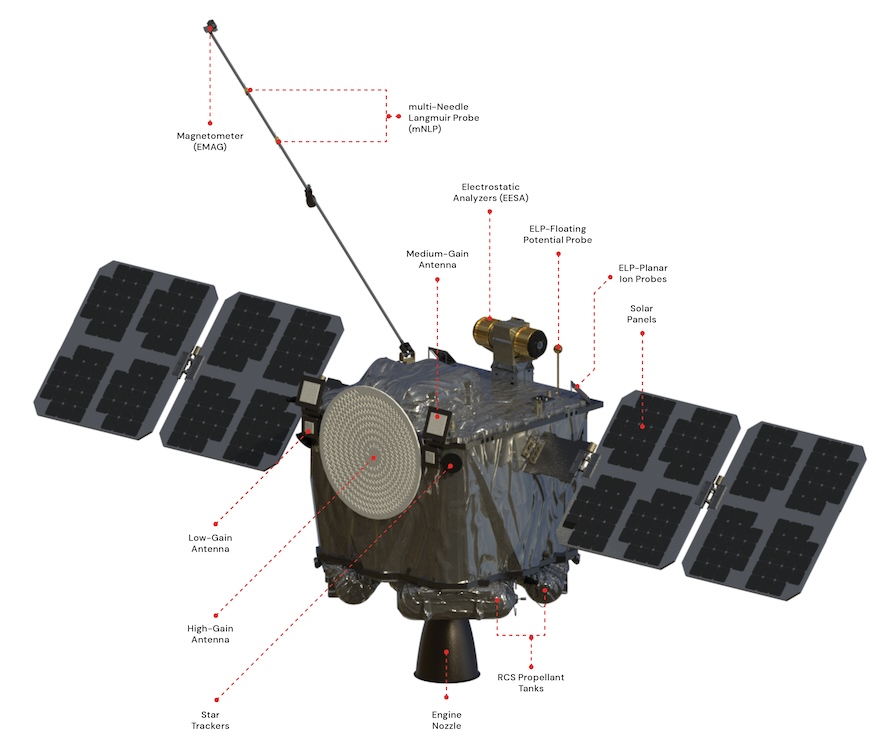The twin ESCAPADE spacecraft have return to Florida for processing ahead of a launch on a New Glenn rocket. Credit: Rocket Lab
WASHINGTON — The second launch of Blue Origin’s New Glenn rocket, carrying a NASA smallsat mission to Mars, is now expected in late October or early November.
The launch of the Escape and Plasma Acceleration and Dynamics Explorers, or ESCAPADE, mission was scheduled for no earlier than Sept. 29 from Cape Canaveral, Florida, according to a Blue Origin social media update last month. A launch on that date appeared increasingly unlikely given the state of both spacecraft and launch vehicle preparations.
Speaking at the end of a NASA webcast for the Sept. 24 launch of three space science missions on a SpaceX Falcon 9, Tim Dunn, senior launch director in NASA’s Launch Services Program, said ESCAPADE is now expected to launch near the end of October or the first week of November. His program procured the launch through the Venture-Class Acquisition of Dedicated and Rideshare, or VADR, contract vehicle.
“We believe we’re targeting very late in October, maybe the first week in November, for ESCAPADE to launch on a New Glenn rocket,” he said.
His comments came two days after NASA and Rocket Lab, the spacecraft manufacturer, announced that the twin smallsats had returned to Florida for payload processing. At the time, both the agency and the company said the launch was scheduled for no earlier than this fall.
The ESCAPADE spacecraft, nicknamed Blue and Gold, were originally shipped from Rocket Lab’s Long Beach, California, factory to Florida in August 2024 for a launch then scheduled for October of that year. However, NASA halted preparations in early September when it determined New Glenn would not be ready in time for a launch window that closed in late October.
The spacecraft returned to Long Beach to await a new launch date. Rocket Lab noted in a Sept. 12 social media post that the spacecraft were completing tests ahead of returning to Florida. Three days later, at the World Space Business Week conference in Paris, Laura Maginnis, vice president of New Glenn mission management at Blue Origin, said the launch would take place “in the coming weeks” but was not more specific.
The upcoming mission will be the second launch of New Glenn, following the vehicle’s inaugural flight in January. That launch, carrying a tech demo payload that remained attached to the upper stage, successfully reached orbit, although the booster was lost during an attempted landing on a downrange ship.
Blue Origin had planned to conduct the second launch of New Glenn as early as this spring, and a year ago outlined plans to perform 8 to 10 launches in 2025. Maginnis said at the Paris conference that Blue Origin was building out a fleet of several boosters and had eight upper stages in storage, promising to launch “multiple times per month” in 2026.
ESCAPADE does not face the narrow launch windows typical of other Mars missions. A team at Advanced Space, a company supporting the mission, developed multiple trajectories where ESCAPADE could loiter in Earth orbit or around the Earth-sun L2 Lagrange point before heading to Mars in 2026.
That approach allows ESCAPADE to launch “virtually any day” this year, said Jeffrey Parker of Advanced Space in a presentation at the Small Satellite Conference in August.
“It’s been a long road, but we are so excited to be launching Blue & Gold on their mission to understand the Martian space weather environment,” Rob Lillis, principal investigator for ESCAPADE at the University of California Berkeley Space Sciences Lab, said in a Rocket Lab statement about the arrival of the spacecraft at the launch site.
Jeff Foust writes about space policy, commercial space, and related topics for SpaceNews.
He earned a Ph.D. in planetary sciences from the Massachusetts Institute of Technology and a bachelor’s degree with honors in geophysics and planetary science…
More by Jeff Foust
Post navigation

